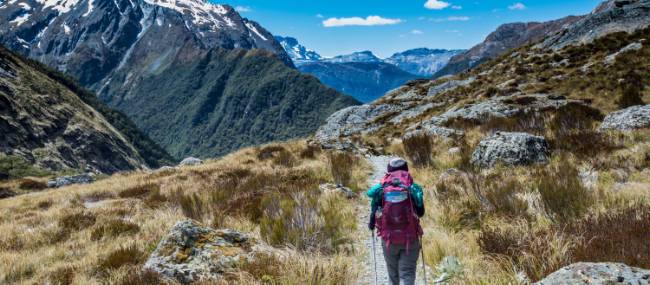
'Tramping' the Routeburn Track | Julianne Ly
Blog home / What's the difference between a walk, hike, trek and tramp?
Is it a walk, hike, trek or tramp? We break down what these words mean to outdoor travellers.
There are many age-old debates still raging around the world. Which came first, the chicken or the egg? Vegemite or Marmite? Is Marvel better than DC? Cycling or walking? Should cereal be eaten with hot milk or cold?
World over, these questions are far and wide and often spark the most interesting of conversations and heated debates. We bet you are thinking about your own answers right now, but is it the same as your partners, friends or colleagues, or is it a matter of personal opinion and perception?
The debate over whether it is a walk, hike, trek or tramp has been a hotly contested subject in the walking community. So when does a walk become a trek? Is it when the terrain is perhaps rougher and the walk harder going? The definition of a trek is perhaps the easiest to decipher – it's more remote and longer than a hike. But then, what's considered a hike?
Confused yet?! Let's break it down according to the consensus of our outdoor travellers on what these words might mean.
Walk: A walk tends to be done on defined tracks and reasonably smooth surfaces without too many obstacles in the way. Walking does not tend to need special equipment apart from a day pack with the essentials, and generally, walks are around regions where accommodation is readily available. Walks are shorter in duration and can be enjoyed by any age group with relative fitness.
Hike: A hike tends to be longer and harder walks, usually on trails through the mountains or through bush or countryside terrain. The trails are generally visible, but not the smooth surfaces of a walk. Hikes tend to be longer than walks and require proper equipment and footwear, as terrain and trails are more rugged. Hiking tends to see you move from lower to higher as you progress and are generally more undulating than a walk.
Trek: A trek is used to define a walk or hike which tends to be multi-day, remote, little in the form of accommodation (generally camp-based) with trails that are either partially visible or not visible at all and where altitude or other rugged terrain and crossings may be encountered. Treks require the most specialised equipment and will probably see you without a shower for days. Treks are generally in regions where other forms of transport other than being on foot are not possible and where you tend to carry your own gear and backpack.
The most interesting of all is 'tramping'. Seems this is something Kiwi’s came up with to define a walk in the bush, whereas Aussie’s would call it 'bushwalking'.
Tramping: Elsewhere in the world, it would be called backpacking, rambling, hill walking, or bushwalking. New Zealanders see it as walking over rough terrain, often with a backpack and wet-weather gear and needing to carry equipment for cooking and sleeping. Did Kiwis not like the word 'hike,' or did they think this was a 'walk' but for intrepid outdoor enthusiasts?
Well, Kiwis weren't the only ones to come up with their own terms. Here are some more quirks from the walking community:
Rambling: Mostly used in the UK, this word is used for walking in the countryside with many rambling clubs and groups, meeting to take part in this outdoor pastime. Rambling was an outdated English expression meaning to wander without purpose, but Ramblers walk with purpose and on defined routes. Hill walking is also commonly used for walking in the mountains and hills in the UK.
Nordic Walking: Now, we're sure you have seen Nordic walkers around, that is, walkers with sticks! It evolved from a type of ski training out of the snowy season and seems to not only have stuck but become popular around the world. Specially designed poles give more power and support whilst walking and a fantastic all-body workout.
Pilgrimage: This one is a walk with purpose. Usually, it can be defined as a journey to an unknown or foreign place. A journey of discovery, an inner journey to find meaning in oneself or nature. A pilgrimage tends to be long-distance, challenging the body and mind at the same time and often leading to personal transformation and development. Some of the most famous ones are the Camino de Santiago in Spain and the Kumano Kodo in Japan. Most on a pilgrimage have a reason for undertaking and completing it, which stems deeper than simply a love of walking and the outdoors.
The debate between what makes a walk a hike or a hike a tramp will be around for years to come, and while we didn't set out to answer the question, we wanted to open the discussions next time you think about heading outdoors. Will you walk? Will you trek? Let us know what you call it in the comments below!